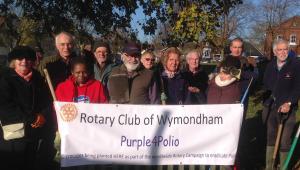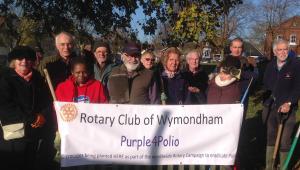Moringa & Tephrosia
This is a project that the international and Foundation Committee launched in 2019. Updates about the project are contained here.

Please see this report from Paul Keely
PROGRESS WITH MORINGA PLANTING
INTRODUCTIONIt is appropriate to start this report by thanking Wymondham rotarians for their donation of £200 to promote the planting of Moringa oleifera. Moringa is a tree which is attracting considerable attention at present because of its exceptional benefits in terms of nutrition and health. We presume that your club members are familiar with these benefits, but if not we would recommend some of the clips on You Tube, such as https://youtu.be/L9tdLn_Zk1M -‘Moringa the miracle tree’.
Newcastle-Gosforth Rotary Club in partnership with Sustainable Global Gardens [SGG] is currently implementing an agroforestry project in East Africa with a planting target of 100,000 trees. The tree species to be planted all have specific uses for farmers, who plant most of the trees in their own plots. Moringa oleifera is one of the species we wish to promote, so the £200 donation from Wymondham Rotary Club was incorporated within the Gosforth project.
SGG had previously implemented two tree-planting projects in Busia County, West Kenya. As part of those projects only a few Moringa had been planted as this was not a tree species with which most of the farming population were familiar. However, many of those farmers are very receptive to innovation, so this network of farmers known to SGG seemed a good place to promote the growing of Moringa.
Here [see above left] is MADEI’s demonstration plot at Matayos in 2016. Inbetween the raised beds for vegetable production there are more than 10 Moringa trees. However, the members of MADEI had not yet learned the best way to harvest moringa by coppicing & pruning. Since then these trees have been rigorously pruned to make harvesting the nutritious leaves easier. Also [see above right] farmers around Siguli Orphans Centre were given a variety of seedlings to promote agroforestry on their own plots in April 2019. One of the preferred species was moringa with an estimated 500 moringa seedlings given to the guardians of 161 orphans & vulnerable children. However, many of those guardians have yet to learn how best to use moringa in their cooking.
As our farmer communities were just learning the benefits of Moringa oleifera, it was decided that the best use of the Wymondham donation was to give Busia farmers priority but then not to exclude farmers from elsewhere who were interested in moringa. In particular farmers on Rusinga Island, not in Busia but one of the poorest parts of West Kenya, were paid for any new moringa seedlings planted.
During this SGG monitoring field visit I also spent 3 weeks in North-East Tanzania. Here Moringa oleifera is known, and called ‘mlonge’, but I did not find many major producers. Neverthless, one of our partners, who lives in Mamsera village in Rombo District, agreed to find seeds and provide 100 moringa seedlings for farmers within his tree-planting group. Also the diocesan tree nursery at the Lutheran cathedral in Same had an estimated 400 seedlings which were about to be distributed to young members of the church as part of the youth support programme.
SGG has been supporting the planting of Moringa among Rusinga farmers for 5 years. On the left Hezra Omwona shows SGG Director Carole Keeley one of his many young Moringa trees in 2015. In 2017-8 SGG supported the planting of some 640 moringa seedlings by the Ogolla brothers [see below left]. Both of these illustrations are previous projects not financed by Wymondham Rotary’s donation. However, in November 2109 I had the privilege of counting trees in the moringa shamba of Nancy Onege [see below left]. Here there are hundreds of moringa trees, mixed with mango, citrus and bananas, but payment was made only for the plantings since April 2019. Both Hezra and Nancy are members of RIOFA [Rusinga Island Organic Farmers Association]. RIOFA wish to encourage moringa to be used both to improve local nutrition & health and also for export of the nutritious leaf. Most of the moringa which has been recorded by SGG over the last 5 years is to be found on Rusinga. Busia County is a more recent area of moringa growing.
WYMONDHAM PROJECT
Following the receipt of Wymondham rotary’s donation SGG contacted farmer groups in the Busia area and requested the preparation of 1,000 moringa seedlings to be ready for the long rains of October- November.
When I arrived in Busia in late October progress was much less than I hoped. The tree nursery at Abakhaywa Mulukongo near Bumala had about 1,000 moringa being prepared in nursery pots, but these needed a few more weeks before they would be ready for transplanting. The 25 seedlings which were ready were shared out among 5 members of the group.
Members of Abakhaywa Mulukongo [see above] receive 5 moringa seedlings to plant in their own shambas. There was insufficient time before I left Busia on 7th November to check the progress of those nursery seedlings, but by then Nyusa Farmers had ordered 200 moringa for their own members and the Siguli group had bought 80 small seedlings, which they were keeping in their own nursery [see below left]. Another community group CIF had also ordered 100 moringa from a different nursery near Sioport. SGG will not know how successful this November 2019 planting will be before SGG’s next field monitoring – probably in November 2020.
Another SGG project is to encourage 9 women’s groups who support approximately 450 orphans & vulnerable children to establish kitchen gardens to improve the orphans’ nutrition. This project is in its early stages, so groups like Mukwano [see below right] are still developing their vegetable beds. The plan is that by 2021 each of the 9 groups will receive 100 moringa trees, so nutritious greens can regularly be harvested for the children. Two groups, CIF & Siguli, already have their moringa trees.
The only group I visited in Tanzania which had significant numbers of moringa was the tree nursery managed as part of the youth programme for the Lutheran Diocese of Same. This nursery contained a variety of species [e.g. neem, Senna siamea] suited to the dry conditions prevalent around Same and an estimated 400 Moringa oleifera.
SUMMARY
As nursery managers in Busia had not produced sufficient moringa seedlings by mid-October, this scheme should be regarded as incomplete with further tree counting & monitoring being required before the end of the year. Nevertheless, progress so far is considerable with the Gosforth Rotary tree data accounting for 668 moringa which have been counted or purchased. In addition to that the tree nurseries at Abakhaywa and Same should ensure that many more than 1000 moringa have been planted in the recent rains. Thus, I trust Wymondham rotarians are pleased with the progress so far made.
Paul Keeley
President of Newcastle-Gosforth Rotary Club
Here [see above left] there are moringa seedlings in the Lutheran cathedral nursery at Same. They are ready for transplanting. On 27th November a donation of 43 seedlings of moringa or Senna siamea was made to Ishinde Primary school near Same. Ishinde is located in a dry part of Same District where young trees are often destroyed by wandering goats. Nevertheless the school has 195 trees within its grounds.
back to page above this...

Supporting the International Community - Thanks For Life - End Polio Now
back 'Thanks for Life', is a project involving the clubs and members of Rotary International in Great Britain & Ireland (RIBI), aimed at helping to eradicate polio throughout the world.
'What We Do' Main Pages:

The Rotary Satellite Group provides financial assistance for the important cancer treatment support charity, Star Throwers in Wymondham.
more
'Thanks for Life', is a project involving the clubs and members of Rotary International in Great Britain & Ireland (RIBI), aimed at helping to eradicate polio throughout the world.
more


